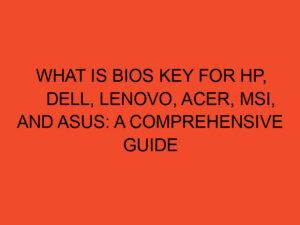Graphics Processing Units (GPUs) play a crucial role in modern computing, powering the graphics-intensive tasks in gaming, multimedia, and professional applications. When exploring the world of GPUs, you might come across various model names and designations. One such designation is “Ti,” which often appears alongside the name of a GPU model. In this article, we will delve into what “Ti” means in the context of GPUs and its implications for performance and features.
Table of Contents
- Understanding GPU Terminology
- What is a GPU?
- GPU Models and Naming Conventions
- The Meaning of “Ti” in GPU Models
- Enhanced Performance and Features
- Differentiating Ti Models from Non-Ti Models
- Popular Ti Models in the Market
- Benefits of Choosing a Ti GPU
- Factors to Consider When Choosing a Ti GPU
- Tips for Optimizing Performance on a Ti GPU
- Ti GPUs in Gaming and Content Creation
- Future Trends and Developments for Ti GPUs
- Conclusion
- FAQs
Understanding GPU Terminology
Before we dive into the specifics of “Ti” in GPU models, let’s briefly understand the terminology associated with GPUs. GPUs are specialized processors designed to handle complex mathematical computations required for rendering graphics. They excel at parallel processing and are highly efficient in handling tasks like real-time rendering, image processing, and data-intensive calculations.
What is a GPU?
A GPU, or Graphics Processing Unit, is a specialized electronic circuit that accelerates the creation and rendering of images, videos, and animations. It works in conjunction with the central processing unit (CPU) to offload the graphics-related workload and provide smooth and immersive visual experiences.
GPU Models and Naming Conventions
GPU manufacturers release a range of models to cater to different market segments and user requirements. These models often come with unique names and designations to differentiate them from one another. Understanding the naming conventions used by GPU manufacturers can help users make informed decisions when choosing a GPU.
The Meaning of “Ti” in GPU Models
The “Ti” designation in GPU models stands for “Titanium.” When a GPU model includes “Ti” in its name, it indicates that it is an enhanced or upgraded version of the base model. The inclusion of “Ti” suggests that the GPU offers improved performance, additional features, or both when compared to its non-Ti counterpart.
Enhanced Performance and Features
Ti GPUs typically boast higher clock speeds, more CUDA cores (the parallel processors within the GPU), and increased memory bandwidth. These enhancements result in improved performance and faster rendering times, making Ti GPUs ideal for demanding tasks such as gaming, video editing, 3D modeling, and machine learning.
Differentiating Ti Models from Non-Ti Models
To differentiate Ti models from their non-Ti counterparts, GPU manufacturers use the “Ti” designation in the product name. For example, if a base model is called “GPU X,” the enhanced version might be named “GPU X Ti.” This clear distinction helps consumers identify and select the specific GPU variant that best suits their needs.
Popular Ti Models in the Market
Several popular Ti GPU models have gained recognition in the market due to their exceptional performance and advanced features. Examples include the NVIDIA GeForce RTX 3080 Ti, the AMD Radeon RX 6900 XT Liquid Cooled Edition, and the MSI GeForce GTX 1660 Ti Gaming X.
Benefits of Choosing a Ti GPU
Opting for a Ti GPU offers several benefits. These GPUs deliver better gaming experiences with higher frame rates and improved image quality. They also excel in content creation tasks, allowing professionals to render complex scenes, apply intricate visual effects, and speed up their workflow. Additionally, Ti GPUs are well-suited for machine learning and scientific simulations, where faster processing times are crucial.
Factors to Consider When Choosing a Ti GPU
When selecting a Ti GPU, there are a few factors to consider. These include your budget, the specific requirements of your intended applications, compatibility with your system, power consumption, and cooling solutions. By carefully evaluating these factors, you can make an informed decision and choose a Ti GPU that meets your needs.
Tips for Optimizing Performance on a Ti GPU
To maximize the performance of a Ti GPU, it is essential to follow a few optimization tips. These include keeping your GPU drivers up to date, ensuring adequate cooling for optimal thermal management, optimizing in-game settings, and utilizing software tools to monitor and fine-tune performance parameters.
Ti GPUs in Gaming and Content Creation
Ti GPUs are highly sought after by gamers and content creators alike. Gamers benefit from the increased frame rates, real-time ray tracing, and advanced AI features offered by Ti models, resulting in immersive and visually stunning gaming experiences. Content creators, on the other hand, appreciate the accelerated rendering times and improved productivity when working with high-resolution videos, complex 3D models, and detailed visual effects.
Future Trends and Developments for Ti GPUs
As technology continues to advance, we can expect further developments and innovations in the realm of Ti GPUs. Manufacturers will likely introduce new Ti models with even higher performance, improved power efficiency, and enhanced ray tracing capabilities. These advancements will drive the boundaries of visual realism and provide users with even more powerful tools for their creative endeavors.
Conclusion
In conclusion, the “Ti” designation in GPU models signifies an enhanced version of the base model, offering improved performance and additional features. Ti GPUs deliver superior performance in gaming, content creation, and other computationally intensive tasks. By understanding the implications of “Ti” in GPU models, users can make informed decisions and choose a GPU that aligns with their specific needs and requirements.
FAQs
Are Ti GPUs only available from specific manufacturers?
No, Ti GPUs are not limited to specific manufacturers. Both NVIDIA and AMD offer Ti variants of their GPU models, providing users with a wide range of options.
Do Ti GPUs consume more power than non-Ti models?
Ti GPUs often have higher power requirements due to their increased performance and additional features. Users should ensure their power supply unit can handle the power demands of a Ti GPU.
Can I use a Ti GPU for cryptocurrency mining?
Yes, Ti GPUs can be used for cryptocurrency mining due to their high computational capabilities. However, factors such as power consumption and mining profitability should be taken into account.
Is it worth investing in a Ti GPU for casual gaming?
While a Ti GPU offers enhanced performance, it may not be necessary for casual gaming. It is recommended to assess your gaming requirements and budget before deciding on a GPU.
Will Ti GPUs become obsolete quickly with new releases?
While new GPU releases may offer improved performance, Ti GPUs remain powerful and relevant for a considerable period. The decision to upgrade should be based on your specific needs and the advancements in technology.





